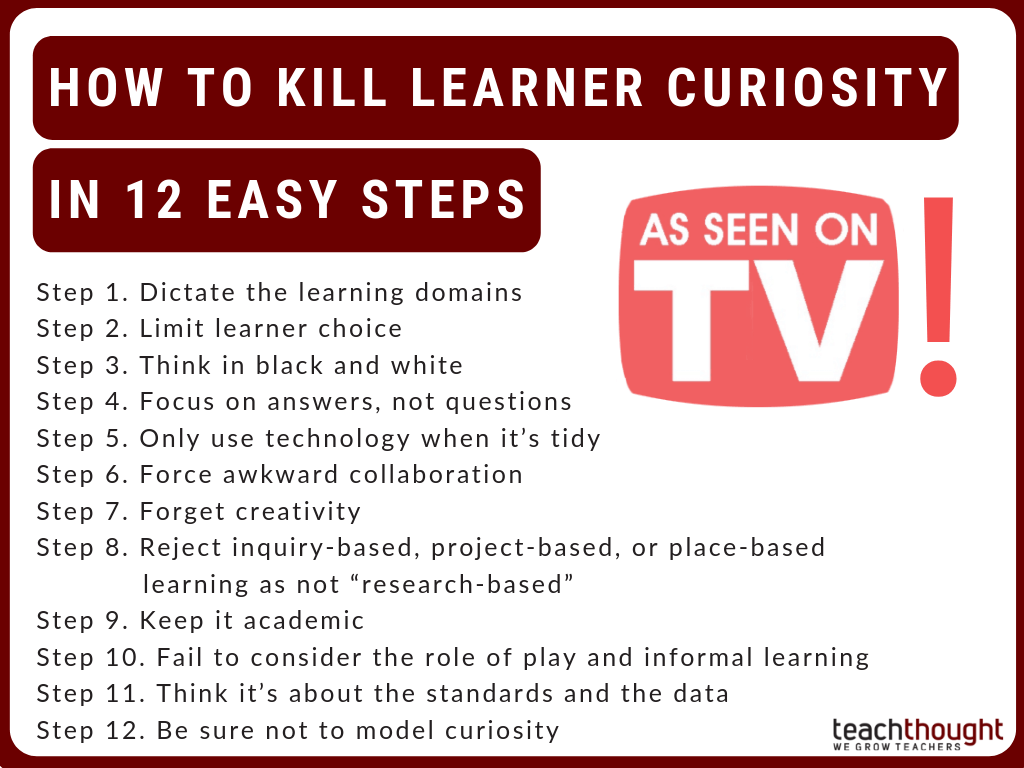
Killing Learner Curiosity In 12 Easy Steps
by Terry Heick
Killing a learner’s natural curiosity doesn’t happen overnight. It can take as long as 12 years, and in some rare cases even that isn’t long enough.
Learning environments focused on standards, assessment, and compliance allow for the implementation of research-based strategies in pursuit of streams of data to prove that learning is happening. Curiosity is nice, but it’s a monumental challenge to measure.
And who ever qualified for a job by demonstrating how strong their curiosity is anyway?
Below are twelve tips to help stifle learner curiosity and keep the learning nice and tidy in your classroom this school year. And please share any we missed in the comments below or on the TeachThought facebook page.
How To Kill Learner Curiosity In 12 Easy Steps
Step 1. Dictate the learning domains
Whether physical or digital, individual or group, you’re the teacher (or ‘district curriculum coordinator’). You decide what is to be learned when and how, and on whose grounds. Make the schedule, the curriculum, the tests, the grading system, the feedback loops–all of it. That’s what you’re paid to do.
Step 2. Limit learner choice
Voice and choice sound great in theory, but who knows better what a learner needs than the teacher. They’ll appreciate you when they get older and can read and write.
Step 3. Think in black and white
Right is right. And if they’re wrong, it does no good to coddle them. Binary thinking is how we got to Mars.
Step 4. Focus on answers, not questions
Again, see #3. No matter how they perform in your open-ended, hippie-style project-based learning that seeks out personalization and community, the standards-based exams, university expectations, and ‘real world’ aren’t like that. The process of arriving at an ‘answer’–thought–pales in priority to accuracy.
Step 5. Only use technology when it’s tidy
Learning simulations, social videos, AI, and blogging are great when they don’t cross lines, invite rule-breaking, or make assessment a challenge. Just make sure you check state, district, and school policy before you send a student to YouTube to ‘learn.’
Step 6. Force awkward collaboration
Collaboration is the stuff of legend. Whenever you can cram a partner or group-activity in where individual thought and reflection used to be, do it. Collaboration makes miracles even if the learning objective doesn’t seem to suggest it.
Step 7. Forget creativity
The real world might be filled with color, sound, and physical movement, but in the classroom it’s messy, distracting, and difficult to manage. Nip it in the bud.
Step 8. Reject inquiry-based, project-based, or place-based learning as not ‘research-based’
Research and data are the real engines to ed reform. Data. Measure it, refine, and bask in the glow of the data. Socrates, Shakespeare, Kant, Newton, and Einstein were all educated with researched-based, data-driven pedagogy. If there’s no data showing it works, reject it.
(And whatever you do, don’t build better data collection tools to attempt to measure the effectiveness of progressive learning tools yourself. Leave that work to Marzano, Hattie, and Stiggins.)
Step 9. Keep it academic
Learning is in schools, laboratories, and formal field work for a reason. ‘Authenticity’ is an antonym for rigor. Keep it formal, sterile, and academic. Leave the children’s lives, their family traditions, cultural legacy, and individual gifts out of it.
Step 10. Fail to consider the role of play and informal learning
If it can’t be measured or directed as a learning outcome in a backwards-planning format, its dangerous, and could disrupt the learning process entirely.
Step 11. Think it’s about the standards and the data
Learning standards are one way to ensure an even learning experience for all students. Work backwards not from habits of mind, evolving learning currencies, or the way students seek out and use information, but rather the standards.
And do so with brutal efficiency.
Step 12. Be sure not to model curiosity
Spend very little time authentically modeling how to ask great questions, seek out information yourself, or react playfully but swiftly when you realize your own knowledge is insufficient. They need to see a teacher as a model of knowledge and expertise, and most of all, ultimate authority.
Ed note: This has been updated from a 2012 post that you may or may not have already read..
Image attribution flickr users zbigphotography, aartx1, albertogp123, marcalandavis, and brett jordan under Creative Commons license. How To Kill Learner Curiosity In 12 Easy Steps
